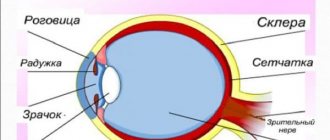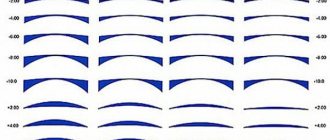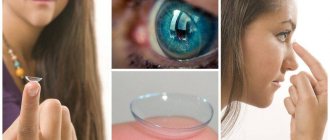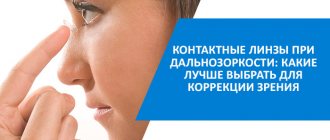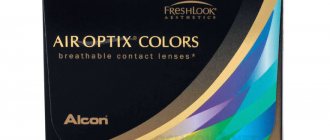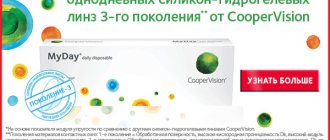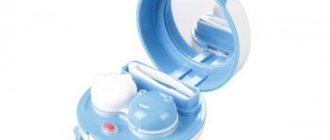Why have specialists increasingly started prescribing contact lenses instead of glasses for children lately? What contact lenses and care products are acceptable for children? You will find answers to these and other questions related to the selection of contact lenses for children in our material.
- Changing attitudes towards the selection of contact lenses for children
- What can prevent problems?
- Child-Friendly Contact Lenses
- Solutions and drops suitable for children
Until recently, the selection of contact lenses for children caused a lot of concern among specialists. Despite the fact that ophthalmologists and optometrists have long understood all the advantages of contact vision correction for children, most of them continued to prescribe glasses as the main means of correction. However, recently priorities have begun to change in favor of contact lenses. In this article, we will look at the reasons for this change in opinion among experts, and also discuss examples of contact lenses and contact lens care products that are acceptable for children.
Changing attitudes towards the selection of contact lenses for children
According to a 2010 study by the American Optometric Association (AOA),1 more than half of the optometric professionals surveyed—51.2%—believed that children are the best candidates for initial soft contact lens fitting. aged 10 to 12 years, 23.6% of respondents agree that these are children from 13 to 14 years old, and 12.4% believe that contact lenses should be selected for children already at the age of 8-9 years, and 11, 9% are confident that contact lenses can be prescribed to children under 8 years of age (Fig. 11).
Rice. 1. Experts’ opinion on children’s age most suitable for the initial selection of soft contact lenses
Recently, specialists in the field of optometry are increasingly prescribing contact lenses to their young patients as the main means of vision correction, and glasses as a secondary means. Contact lenses are a highly desirable form of vision correction for most children for a number of reasons. They not only save children from the sticky nickname “bespectacled”, but also have properties that are important for the full development of children’s vision and, in general, for the general physical development of a child or teenager, since they:
- do not limit the peripheral field of vision, do not distort the actual size of objects and the distance to them, thereby not complicating spatial orientation;
- do not fall out of sight, providing greater freedom of movement;
- are not traumatic.
According to the study mentioned above, of the 576 optometrists surveyed, 21% said they were now more willing than a year ago to prescribe contact lenses to children aged 10 to 12 years as their first choice for vision correction. Two thirds of respondents (49%) began to recommend contact lenses for this purpose to adolescents aged 15-17 years.
How can we explain the transition of specialists involved in children’s vision correction to contact lenses? For 29.5% of respondents, the decisive factor was the emergence of daily replacement lenses, for 23.3% - the development of more advanced materials for contact lenses with a high degree of wettability, low elasticity modulus, high oxygen transmission, etc.; 19.2% of respondents began to more often select contact lenses for children due to increased requests for this from young patients or their parents. Finally, for 10.3% of specialists, the basis for making a decision in favor of contact lenses were the positive results of recent studies in the field of correction and control of myopia using contact lenses in children, and for 9.6% - the high physical activity of children, their participation in sports competitions (Fig. 2).
Rice. 2. Reasons why specialists have become more willing to select contact lenses for children
Can wearing contact lenses stop the deterioration of a child's vision?
Vision problems in the overwhelming majority begin in childhood, during school and college years, when the eyes are subject to heavy visual load, this especially applies to those who have a parental predisposition; unfortunately, it will most likely have its say and your vision will have to be corrected.
You may be interested in Manufacturing contact lenses: technology, methods
Contact lenses do not have a direct effect on vision, experts in this matter have come to this conclusion, but there are those who think otherwise. To a greater extent, vision deteriorates when wearing lenses in cases where a person encounters various complications as a result of violations of the rules of storage and wearing.
A common belief is that lenses can stop vision deterioration, but this is not true, “rigid gas permeable contact lenses” have a certain effect. Research into the effects of contact lenses on vision continues; most recently, scientists from the USA and Australia have proposed a theory for changing the design of contact lenses in order to inhibit the development of vision impairment. Ciba Vision has already acquired a patent for such lenses, but so far no such lenses have been presented.
What can prevent problems?
However, despite all the benefits of contact vision correction for children, it is necessary to take into account a number of factors, ignoring which can not only negate all the advantages of such correction, but also cause great harm to the vision of a child or adolescent and his health. Let us give two examples from optometric practice that clearly explain what we are talking about2.
Parents came to one of the eye clinics for a routine examination with a 12-year-old child who had been using contact lenses for more than two years to correct and control myopia. All of them were very pleased with the results of using the prescribed lenses. However, the parents expressed concern to the doctor that their son so values the high visual acuity that the lenses provide him that he is ready to ignore pain and discomfort just to continue wearing them. Moreover, the boy tried to hide these unpleasant sensations from his parents. As a result, the doctor decided to switch the child to wearing glasses for some time.
The second case involved an 11-year-old girl who had been wearing contact lenses since she was 9 years old. The results pleased both the doctor and parents. However, during one of the routine examinations, it turned out that this patient had cases of the lens sticking on her eye. In this case, the child, instead of first dropping an artificial tear preparation into the eye and then painlessly removing the lens, preferred to remove it without using a moisturizer. The girl's mother was surprised by her daughter's revelations. Because the girl and her mother insisted on continuing to use contact lenses, the doctor had to refresh their memory on important rules that contact lens users should not forget about.
As the cases described above show, it is not surprising that among the most important factors for specialists influencing their decision to choose contact lenses for a child or not is the latter’s ability to independently use contact lenses and follow all the rules for caring for them, and their awareness of the dangers of non-compliance with these rules . You also need to consider:
- level of personal hygiene of the child;
- degree of participation in sports;
- the influence of contact lenses on his self-esteem, etc.
With all this, of course, we should not forget that children do not yet have the same awareness of the importance of following doctor’s recommendations and life experience as adults do, therefore parents, just like the child, should know the rules of wearing contact lenses.
Advantages and disadvantages of glasses and lenses
Let's look at the advantages and disadvantages of glasses and lenses. Based on them, you can make a choice regarding which accessory your teenager should buy.
Lenses
The advantages of lenses are as follows
:
- Other people will not be able to see that the teenager has vision problems.
- You can choose the “eye color” that your child will have when he puts on the lenses.
- You can choose lenses that are intended for daily wear. So are those models that are designed to be used for several weeks.
- Convenient to use. The child will be able to engage in physical activity while wearing the lenses. Will not be afraid of dropping lenses. As is the case with glasses.
- Difficult to deform. If a child can drop them while wearing glasses, this is impossible with lenses. They sit tightly in front of the child's eyes. And they do not subside even if the teenager actively moves his head.
Disadvantages of lenses
:
- Difficult to care for. The child will have to monitor the lenses daily. So that they are clean and do not damage the membrane of the eyes.
- Expensive. You only need to buy glasses once, and they can be used for several years. This is not possible with lenses. You will have to buy new ones regularly.
- You need to buy only high-quality lenses. A low-quality product can harm the lining of a child’s eye. And will not be able to correct his vision. You can't buy cheap lenses. Because they are dangerous to the health of the wearer.
Child-Friendly Contact Lenses
The above survey also showed which characteristics of contact lenses, according to experts, are the most significant when it comes to children. For all respondents without exception (100%), it was important whether contact lenses provide high visual acuity, then - ease of putting on/removing lenses and high oxygen transmittance Dk/t (99%), comfort (98%), as well as mode wear, or frequency of lens replacement (96%). In addition, a significant factor was the lens's provision of protection from harmful ultraviolet (UV) radiation. This factor influenced the decision that these lenses were acceptable for fitting to children in 75% of cases (see table).
Experts’ opinion on the degree of importance of certain properties of contact lenses, %, when selecting them for children | ||
| Lens property | Very important | Medium importance |
| Comfort | 75 | 23 |
| Oxygen transmission rate | 64 | 35 |
| Ease of manipulation | 53 | 46 |
| Optical properties | 53 | 47 |
| Replacement frequency | 47 | 49 |
| UV protection | 30 | 45 |
As mentioned earlier, for the majority of specialists surveyed, who began to more often select contact lenses for children, a significant argument in favor of this was the emergence of daily disposable lenses (Fig. 3). These daily disposable lenses include SofLens daily disposable (Bausch + Lomb), which are great for both children involved in sports and simply active children. With an improved aspherical design, these lenses eliminate spherical aberrations and provide clear vision, especially in low light conditions. In addition, the optimal thickness of SofLens daily disposable lenses and their constant moisture ensure their comfortable wearing throughout the day.
Rice. 3. A number of daily and biocompatible contact lenses acceptable for selection for children include
Contact lenses acceptable for children also include silicone hydrogel daily lenses 1-Day Acuvue TruEye (Johnson & Johnson Vision Care), which are fully suitable for use during sports and active games. These lenses are made of a unique material, Narafilcon A, which includes a silicone polymer that promotes high oxygen transmission to the cornea (Dk/t = 118 units). Thanks to this, the child’s cornea’s need for oxygen is satisfied 100%, which is a significant factor, since the body consumes more oxygen during physical activity. It is also important for children who spend a lot of time outdoors that the 1-Day Acuvue TruEye lenses have a reliable UV filter that protects their eyes from the harmful effects of ultraviolet radiation: 99% from UVB rays and 97% from UV rays - A- rays.
The new generation Focus Dailies AquaComfort Plus (CIBA Vision) daily contact lenses are also well suited for children. The AquaComfort technology used in them contributes to the comfortable wearing of these lenses and prevents the feeling of dryness. The moisturizing effect is achieved thanks to a special component embedded inside the lens, which is gradually released and moisturizes the lens with every blink. In addition, Focus Dailies AquaComfort Plus lenses are very easy to put on and take off. They are produced using a sterile, high-precision process to ensure they are of high quality and safe to wear.
Further, among the contact lenses acceptable for children is the newest development in the segment of one-day silicone hydrogel lenses - Maxima 1-Day Premium. These lenses combine high moisture content, which means comfort for the user, and high oxygen transmission, which is important for children's eyes. Thanks to the aspherical design, Maxima 1-Day Premium lenses provide the child with clear contrast vision and full color perception. The special design of both surfaces of the lenses not only simplifies their selection, but also promotes a stable fit on the cornea of children and adolescents, which is of great importance when playing sports and outdoor games.
Biocompatible planned replacement lenses of the Proclear family are also widely used when working with children, which include spherical lenses Proclear Sphere, one-day Proclear 1-day, toric Proclear toric and multifocal Proclear Multifocal. These contact lenses are made using unique PC technology, thanks to which they provide children's eyes with ideal hydration and excellent comfort even in conditions of low air humidity, during the child's physical activity and high visual concentration during games.
At what age can you wear contact lenses?
Scientists have found that up to about 3 years of age, children's vision can be improved without resorting to various types of correction. If this does not happen, it is advisable to think about choosing glasses that should be worn until the baby is ready to use another method of correction.
At what age is it acceptable to use optical glasses? Experienced ophthalmologists are of the opinion that you should start wearing contact optical glasses from the age of 10, since at an earlier age children are not able to handle their use with due responsibility.
Before prescribing a correction procedure for your child, you need to make sure that he is mature enough to handle lenses responsibly and follow the rules regarding their care. Children generally have no problem adjusting to these eye aids, but they may not need to be worn all day long at first.
It is necessary for the eyes to gradually get used to contact types of devices: the maximum wearing time on the first day should not exceed 3 hours, while it is recommended to increase it by 1 hour every day.
What is the role of parents when their child wears contact lenses?
Many parents make a big mistake by leaving their child to wear contact lenses without control, being confident in his consciousness and responsibility. Don’t forget, this is still a child, which means that all responsibility falls on the shoulders of his parents. You, as parents, should, like no one else, understand and understand the issue of contact lenses, listen carefully to the doctor when he selects lenses for your child. You must constantly monitor your child in all cases where possible. It is clear that you will not sit with him in class at school, but at home you simply must. Always monitor not only whether the child removes or puts on lenses correctly, whether he stores them correctly, but also pay attention to the condition of his eyes, to the child’s complaints, they may be of a general nature, but you, knowing about lenses, should first pay attention on the eyes.
